Organizational efficiency and information capture have become vital during the current rapid digital time because people need it more than ever. Automated note-taking ai for students software provides modern users with advanced smart capabilities that extend text-recording capabilities. These digital note applications use automation and express arrangements along with knowledge processing and work assignment systems that boost work efficiency and make document control easier.
This article examines 15 modern best AI note taking apps that help users enhance their workflow and improve their note organization experience for students, professionals and creative thinkers. A perfect solution exists that delivers enhanced methods to record ideas along with their organization and usage for productivity.
Top Features to Look for in an AI Note Taking Tools
Look for these in your note-taking application.
1. Cross-Device Synchronization: Give preference to the app that offers live note access across multiple devices.
2. Clean User Interface: A simple interface that is easily navigable to create notes very quickly.
3. Organized: Ensure the app delivers features that are inclusive of folders along with tags and categories so that you organize your notes by structure.
4. Formatting: The app allows users to apply diverse options for text enrichment as well as add images apart from tables and multimedia media.
5. Search Feature: A deep search engine allows access to notes almost instantly by simply searching with some text or labels.
6. Collaboration: The service allows shared notes access together with a real-time edit mode designed particularly for group notes collaboration.
7. Offline Access: People can work on the notes both online and offline because this application always allows access to the system when the internet connection has been lost.
8. Protection: There are two security options available with the application that include password-protected security and encryption features to keep your data safe.
9. Integration with other productivity tools: Compatibility with other productivity tools such as a calendar, task manager, and cloud storage.
10. Customisation: Users who wish to have a personalized note-taking AI for students can choose from various theme options in addition to layout and template settings. Explore more about this AI’s cybersecurity tools to protect all your important online security.
The application builds productivity along with organization and ease of use through its designed features.
List of 15 AI Note Taking Apps
1. Evernote

Users benefit from the versatile capabilities of Evernote which enables them to capture and store thoughts along with organizing ideas without disruption. The application offers users multiple functions for maintaining multimedia content along with web-related note gathering combined with task management systems that function throughout devices.
Users can use the system’s effective search capability involving text recognition to instantly find their notes. The combination of Google Drive and Slack connectivity along with its user-friendly features makes Evernote an excellent choice for both personal and professional users which explains why productivity fanatics choose it.
Features:
- Note syncing across devices
- Web clipper for saving articles and screenshots
- Task management with reminders
- Integration with tools like Google Drive and Slack
- Advanced search with handwriting recognition
Pros:
- User-friendly interface
- Strong organization features with tags and notebooks
- Offline access
Cons:
- Expensive premium plans
- Limited features in free version
Pricing:
- Free
- Personal (₹333.25/month)
- Professional (₹433.33/month)
- Team(₹582.50/month)
Website: evernote.com
2. Notion
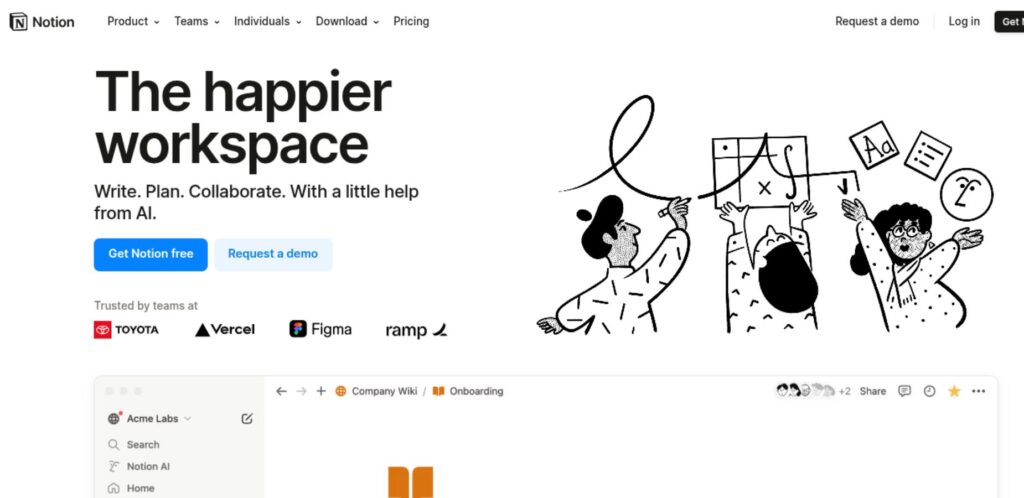
The all-purpose best AI note taking apps workspace Notion allows users to create note-taking ai for students, manage tasks and work together as a team. Notion provides customizable tools to build databases as well as project organization features and workflow management systems.
The features in Notion such as templates and real-time collaboration make it suitable for both personal use and the growth of business operations. Users choose Notion because of its user-friendly design alongside its flexibility features which attract both productivity experts and business organizations.
Features:
- All-in-one workspace for notes, tasks, and databases
- Real-time collaboration
- Custom templates for various workflows
- Cross-platform syncing
- Integration with third-party apps
Pros:
- Highly customizable
- Great for team collaboration
- Free plan with generous features
Cons:
- Steeper learning curve
- Limited offline functionality
Pricing:
- Free
- Plus ($10/seat/month)
- Business ($15/seat/month)
Website: notion.so
3. Microsoft OneNote
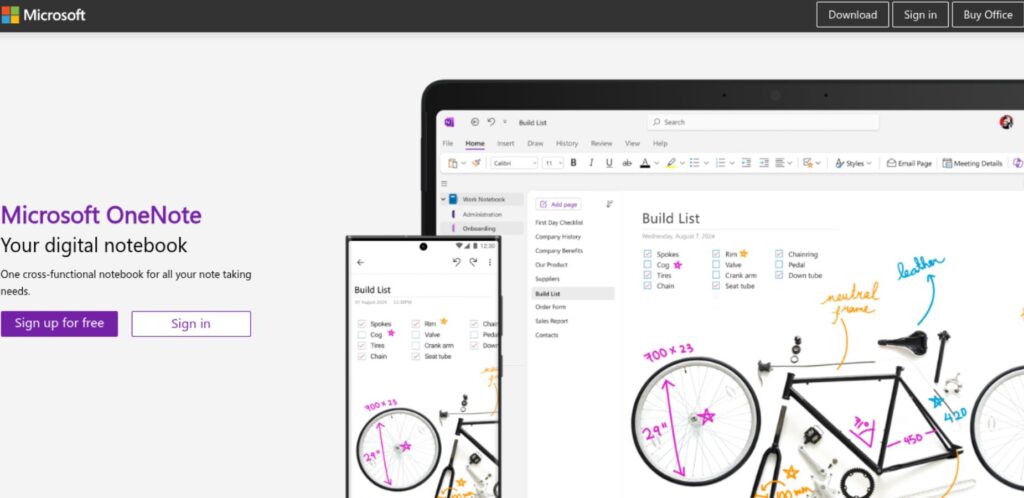
The flexible digital notebook application Microsoft OneNote serves as a freestyle platform to collect, sort and distribute notes between users. Users can utilize OneNote to generate flexible canvases containing text as well as drawings and multimedia notes which sync across multiple devices through Microsoft Office Suite.
The capability for tagging in OneNote enhances organization while handwritten notes create extra convenience for users. Students together with professionals and teams find this digital notebook the perfect solution because it delivers strong tools that boost efficiency for taking notes and working together while managing tasks effectively.
Features:
- Free-form canvas for notes, drawings, and media
- Multi-device syncing
- Integration with Microsoft Office Suite
- Tags for organization
- Handwriting support
Pros:
- Free to use
- Great for Office users
- Advanced note organization
Cons:
- Complex interface for beginners
- Limited export options
Pricing:
- Free (Office 365 subscription for additional features)
Website: onenote.com
4. Krisp.ai

Krisp.ai is a cutting-edge solution that enhances communication quality during virtual meetings and calls. From pre-meeting notes and agendas to follow-ups, everything is arranged for quick reference. Krisp.ai makes every meeting comprehensive, clear, beneficial, and secure for you and your team.
As an AI note taker Krisp.ai silently does all the note-taking in the background for you. It converts your meetings into clear, easy-to-read text with exceptional accuracy. Krisp seamlessly integrates with any voice or conferencing app right away, with no need for extra plugins or extensions. This makes it a great option for companies and professionals who depend on virtual collaboration.
Pros.
- Unlimited Free Transcription
- Bot Free
- Automatic Speaker Assignment
- Enhanced Clarity
- Time-Saving Features
Cons.
- Limited to 60min/day Noise Cancellation on Free Plan
- Limited to 2 AI Summaries/day on Free Plan
Cost (at time of publication):
- Free for individuals to capture meetings & noise cancellation
- $8 per month for unlimited Meeting Assistance & Workspace Collaboration
- $15 per month for admin Controls, Sales Features, Integrations and Priority support
5. Google Keep
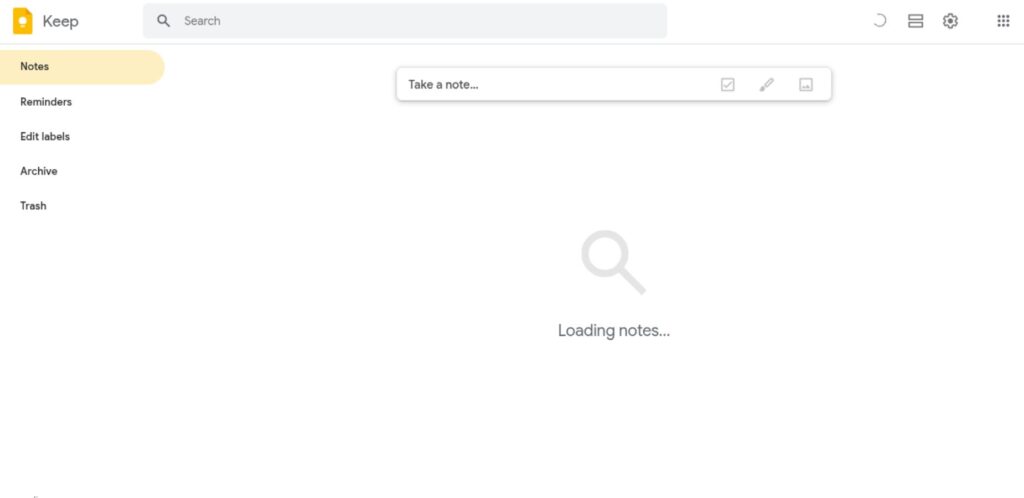
The cloud-based Google Keep application provides users with an efficient top AI note taking apps system that maintains simplicity for fast organizational management. The app exhibits a sticky note interface that enables users to create three types of note-taking ai for students, comprising texts, voices and images.
The app functions within the Google Workspace framework to enable collaboration and produce reminders. Users can take their notes with Keep through any device since it offers automatic syncing functions. Individual users will find this application convenient because of its lightweight design but personal users may discover it lacking features for task organization and advanced text management.
Features:
- Simple sticky note-style interface
- Integration with Google Workspace
- Voice-to-text notes
- Color-coded organization
- Reminders with location and time-based alerts
Pros:
- Free to use
- Lightweight and easy to use
- Great for quick notes
Cons:
- Lacks advanced features
- Limited formatting options
Pricing:
- Free
Website: keep.google.com
6. Obsidian

Obsidian operates as an intense note-taking software that utilizes Markdown syntax to deliver both personal organization and knowledge management techniques. Users can use the app to write and connect notes which develops custom knowledge maps.
The combination of local-first storage features with strong plugins and bidirectional linking enables Obsidian to serve researchers, writers and all individuals who work with substantial information quantities. The program places a premium on privacy together with customization features that include offline use together with a plugin environment for workflow customization.
Features:
- Local-first note storage with Markdown support
- Bi-directional linking for building knowledge graphs
- Plugins for customization
- Strong encryption for data privacy
- Offline-first functionality
Pros:
- Excellent for knowledge management
- No cloud dependency
- Free for personal use
Cons:
- Requires learning Markdown
- No real-time collaboration
Pricing:
- Free
- Catalyst ($25 one-time)
- Commercial ($50/year)
Website: obsidian.md
7. Bear

Apple users can use Bear which provides them with a clean and uncluttered tool for note-saving. The application enables Markdown support as a formatting tool and provides automatic iCloud data synchronization with a focus mode feature to help users write without distraction. The tagging system in Bear along with internal linking provides users with effective ways to organize their ideas and maintain connections between them. Users who need easy note-taking ai for students operations alongside visual appeal alongside lightweight operations will find the perfect solution in Bear.
Features:
- Beautiful, minimalistic design
- Markdown support for formatting
- Cross-device syncing via iCloud
- Tagging and linking for organization
- Focus mode for distraction-free writing
Pros:
- Aesthetically pleasing interface
- Lightweight and fast
- Great for Apple users
Cons:
- Apple-only app
- Requires subscription for syncing
Pricing:
- Free
- Pro ($2.99/month or $29.99/year)
Website: bear.app
8. Zoho Notebook

Users can use Zoho Notebook as their free user-oriented application to generate best AI note taking apps tailored note content while maintaining device synchronization. Users can seamlessly store text audio images and checklists through the notecard system of this application. The tool caters to users who want an easy-to-use visual platform since it provides a smart card linking cross-platform functionality and cloud backup. The Zoho suite integration makes this tool an adaptable system for productive work.
Features:
- Multimedia notes (text, audio, video)
- Note card-style organization
- Syncing across devices
- Smart card for links and embedded media
- Integration with Zoho suite
Pros:
- Free with no ads
- User-friendly design
- Cross-platform support
Cons:
- Limited integrations
- Basic search functionality
Pricing:
- Free
Website: zoho.com/notebook
9. Roam Research

Roam Research serves as a database tool that allows users to generate interconnected notes while monitoring their brainstorming sessions. The tool includes both bidirectional linking features together with graphical displays to presentation ai lecture notes generator relationships. This application caters to writers, researchers, and students along with daily journaling functions, Markdown capabilities and customizable options. The Roam platform helps users construct efficient personal knowledge bases through which they can develop creative insights about complex subjects.
Features:
- Bi-directional linking for note relationships
- Graph view for visualizing connections
- Daily notes for journaling
- Markdown-based note editing
- Custom shortcuts and templates
Pros:
- Powerful for knowledge management
- Excellent for researchers and writers
- Strong community support
Cons:
- Expensive subscription
- Steeper learning curve
Pricing:
- Pro ($15/month or $165/year)
- Believer ($500/ 5 years)
Website: roamresearch.com
10. Nimbus Note

The platform Nimbus Note enables users to produce text along with voice and video notes and supports both rich media and file attachments. The platform enables users to synchronize their data across multiple devices and provides team collaboration features together with an internet content grabber. The combination of customizable workspace and collaborative management features in Nimbus makes it an optimal solution for personal and group work organization which delivers a unified workflow for ai lecture notes and essay generator management.
Features:
- All-in-one workspace for notes, tasks, and databases
- Rich text editor with media support
- Collaboration tools
- Cross-device syncing
- Web clipper for saving online content
Pros:
- Affordable
- Great for teams
- Highly customizable
Cons:
- Interface can feel cluttered
- Limited free version
Pricing:
- Free
- Essentials ($38/month)
- Plus ($98/month)
- Ultimate ($198/month)
Website: nimbusweb.me
11. Coda
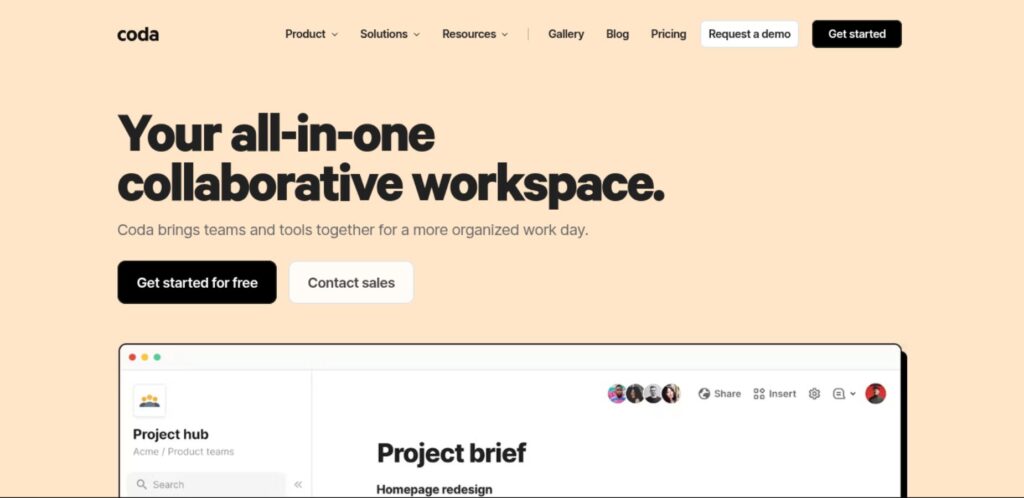
The all-inclusive Coda offers users the combination of notes, free top AI notes generator from video apps and databases together within a single adaptable workspace. Users benefit from Coda because it enables them to build document templates that support real-time team interactions alongside multiple application connections and numerous pre-made formats. Coda provides universal usability that enables users to work both individually and with teams for project administration and additional purposes. Coda provides flexible workflow management tools that people across both businesses and individual users actively utilize.
Features:
- Combines notes, tasks, and databases
- Customizable workflows
- Integration with third-party tools
- Collaborative document editing
- Templates for various use cases
Pros:
- Versatile and powerful
- Great for team collaboration
- Intuitive interface
Cons:
- High learning curve for advanced features
- Expensive for larger teams
Pricing:
- Free
- Pro ($10/doc maker/month)
- Team ($30/doc maker/month)
Website: coda.io
12. Supernotes

The Supernotes application functions with a distinct note-organizing method through its card-style design. The tool makes it possible for users to generate and join ai lecture notes generator and add tags without hassle. Supernotes provides instant team collaboration functionality which benefits group projects. The app offers markdown functionality together with automatic device synchronization that enables users to manage their knowledge base with efficiency while improving productivity. The application provides elementary yet efficient features for individual and organizational purposes.
Features:
- Card-based note-taking system
- Markdown support
- Real-time collaboration
- Tags and linking for organization
- Cross-device syncing
Pros:
- Lightweight and fast
- Unique card interface
- Collaboration-friendly
Cons:
- Limited integrations
- Fewer advanced features
Pricing:
- Free
- Premium ($7.36/month)
Website: supernotes.app
13. Mem

Users can input notes through Mem while this application links and organizes content with tagging functions that stem from context-based recommendation systems. The application implements artificial intelligence technology to optimize note arrangement thus users can efficiently retrieve needed content fast. Users experience a smooth user interface with Mem because the app maintains consistency between their devices. The software serves teams and individuals by raising work efficiency through automated note classification which improves data recovery along with manual work reduction.
Features:
- AI-powered note organization
- Context-based suggestions
- Automatic tagging and linking
- Cross-platform syncing
- Integration with Google Calendar
Pros:
- AI-driven insights
- Easy to use
- Fast and responsive
Cons:
- Limited export options
- Still evolving features
Pricing:
- Free
- Pro ($8.33/month)
Website: mem.ai
14. Agenda

The Agenda app functions as a note-taking tool with date-based organization for macOS and iOS software applications. Users can arrange their notes through specific dates using this application which generates a time-based project overview. Users can edit using markdown in Agenda while the app automatically synchronizes between devices through iCloud along with Apple Calendar support. Users requiring chronological ai lecture notes generator management along with real-time collaboration features will find Agenda to be the ideal choice because it provides visual timeline tracking of their work across time.
Features:
- Date-focused note organization
- Timeline view for projects
- Integration with Apple Calendar
- Markdown support
- Syncing via iCloud
Pros:
- Great for time-based notes
- Seamless integration with macOS and iOS
- Free basic plan
Cons:
- Apple-only
- Limited free version features
Pricing:
- Free
Website: agenda.com
15. Craft
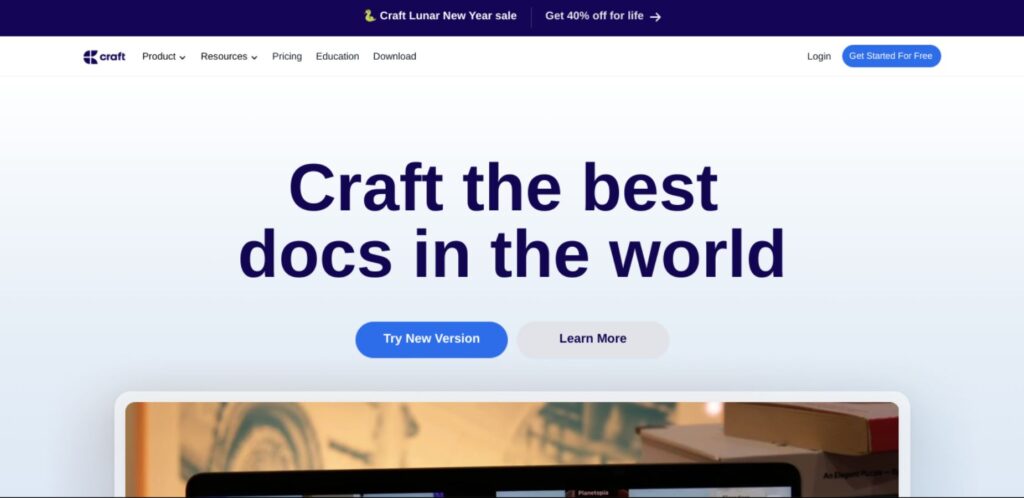
Craft provides individuals together with teams with a stylish interface to create notes generator from video and documents. The best AI note-taking apps provide a sophisticated text editor that supports all types of media content while enabling immediate collaboration features along with automatic device synchronization. The document creation platform Craft provides both project management capabilities as well as document creation abilities through its template editor comment features and sharing functions. This application caters optimally to users who belong to the Apple technological environment.
Features:
- Rich text editor with visual design
- Collaboration and sharing options
- Cross-device syncing
- Integration with third-party tools
- Offline-first functionality
Pros:
- Beautiful UI
- Great for document creation
- Supports multimedia
Cons:
- Limited free plan
- Apple-centric
Pricing:
- Free
- Plus ($4.8/month)
- Family ($9/ month)
- Team ($30/month)
- Business ($150/ month)
Website: craft.do
16. Quip

Quip operates as a collaborative productivity platform that unites search functions with messaging capabilities and task management app capabilities with the capacity to work on document and spreadsheet content. Users can collaborate in real-time using this platform because it lets teams cooperate on shared files and projects and monitor task progress. Organizations that need integrated all-in-one solutions should consider Quip since it works with Salesforce. Users can access and work on Quip through mobile devices in addition to desktop platforms.
Features:
- Notes, documents, and spreadsheets in one
- Real-time collaboration
- Integration with Salesforce
- Task and project management tools
- Mobile and desktop support
Pros:
- Great for teams
- Combines multiple tools in one
- Strong collaboration features
Cons:
- Expensive for small teams
- Limited formatting options
Pricing:
- Starter: $10/user/month
- Plus: $25/user/month
- Advanced: $100/user/month
Website: quip.com
AI Note Taking Apps Work-Life Balance
1. Prioritisation: Note-taking apps allow users to prepare lists of work and personal assignments so that one can manage all his commitments by proper prioritization.
2. Easy Management: The reminder and scheduling feature makes it possible for these ai notes generator from video to distribute time for both work and leisure activities with proper balance so that a well-planned daily schedule is evolved.
3. Easy to organise: Centralized organization advantage includes the storage of work notes, personal plans, and ideas in one place, removing the stress associated with the management of various tasks.
4. Better Focus: You have structured access to instant notes. This eliminates the distraction in the workplace and keeps you focused on work and life.
5. Stress Management: Stress can be relieved either through note journaling or through brain-dumping in your note-taking application.
6. Easy Collaboration: This helps to achieve better communication and sharing of responsibilities about your notes generator from video with your colleagues and family members.
7. Work and Personal Boundaries: Because you need different roles between professional and personal, work-related content needs to stay in separate folder sections with personal notes.
Note-taking tools provide the capabilities to stay structured while being efficient at work, which results in maintaining a beneficial work-life equilibrium.
Conclusion
To sum up, the integration of AI technology in note-taking eliminates traditional methods of information organisation and management. Real-time transcription among other sophisticated features through these tools serves both students in their learning process while delivering workplace flexibility for professionals who manage their workflows.
The selection of AI note-taking apps should consider its distinctive functions because users need to match features with their priorities. Tools driven by innovation enhance user productivity and organizational efficiency which allows them to outperform others in the fast-forward modern world. The development of future notes generator from video solutions is conducted by AI-driven systems.
FAQs
1. Define an AI note taking apps based on artificial intelligence.
The artificial intelligence functionality in AI note-taking applications provides users with assistance to capture notes alongside organizational help and note management features. These applications offer functionality that includes real-time documentation processing together with automated sorting demands scheduling prompts and searching tools which improve work efficiency.
2. These products boost efficiency by what means?
Such apps do repetitive work for users by helping them sort notes alongside setting alert notifications and condensing written information. Voice-to-text transcription along with keyword-based search provides users with quicker access to their data while reducing the time needed for these operations.
3. Are AI note-taking apps secure?
The majority of AI note-taking services focus on safety through the implementation of data encryption standards along with password security systems and cloud storage framework regulation. Secure data must be the top priority when selecting applications because they should implement strong protective security features to safeguard sensitive information.
4. What are the capabilities of AI note-taking apps to connect with other supporting tools?
Many AI note taking apps enable users to integrate their solutions with both productivity applications and project management tools and cloud-based storage solutions to establish continuous platform connectivity.
5. Will AI note taking apps meet the needs of users both in their personal lives and work environments?
Absolutely! The variety of users who find value in AI note taking apps is extensive. These applications serve both professional workers handling duties and students planning academic subjects while enabling personal users to maintain their objectives and thought records.

